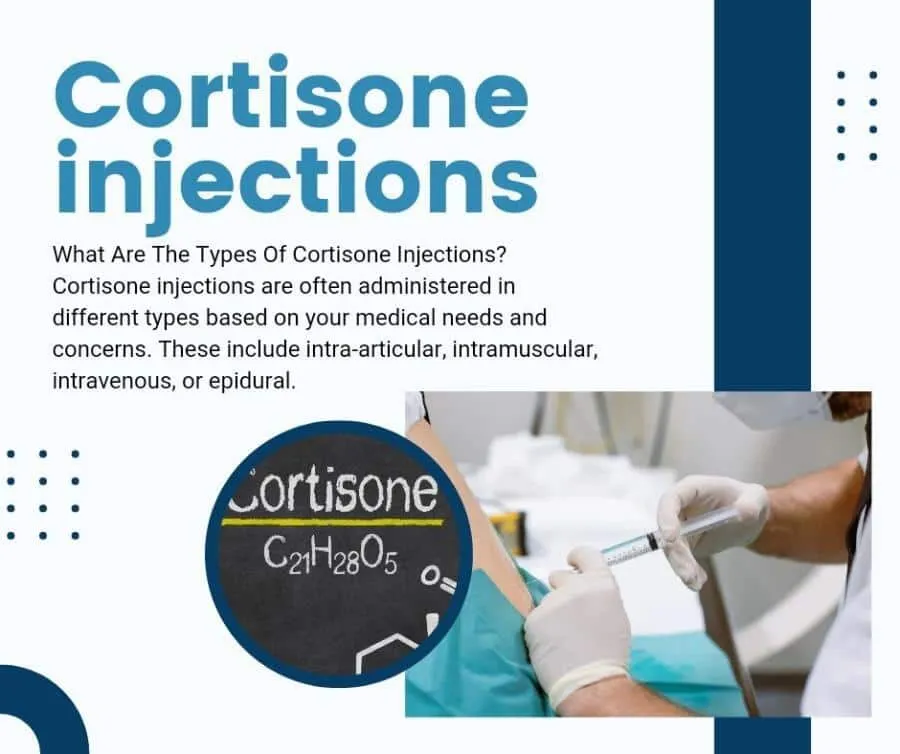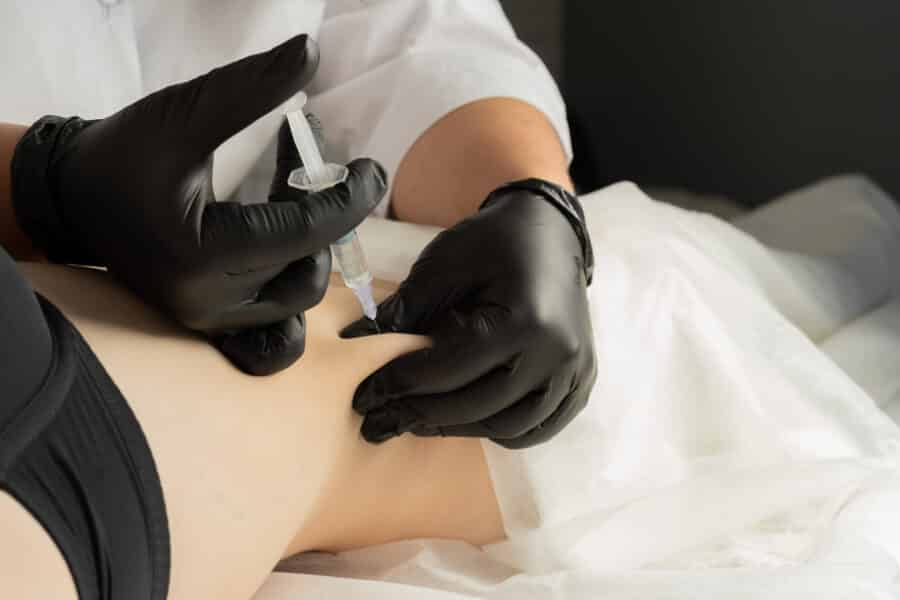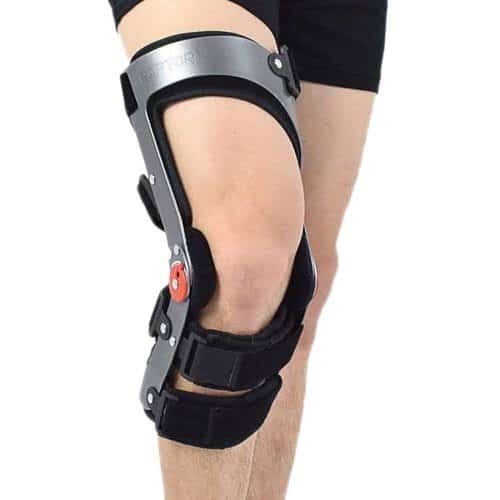Cortisone injections are steroid shots often used to reduce pain and acute or chronic inflammation of the body and joints. Also, it’s not the anabolic steroid usually abused by competitive athletes, bodybuilders, weightlifters, and powerlifters.
Over the decades, cortisone injections have been proven safe and effective when treating pain and improving mobility in the muscles, ligaments, joints, and other body areas. Due to its power, it’s often referred to as the ‘miracle drug.’
Also, cortisone shots are composed of artificially-made cortisone hormones that your body naturally produces through your adrenal glands. Medical professionals use these synthetic compounds to treat various conditions, including autoimmune disorders.
However, not everyone is a good candidate to receive cortisone injections. They may cause severe unwanted side effects and interact with medications you’re currently taking.
If you want to understand further how cortisone injections can help your body, you may follow this link, consult with your doctor, or continue reading this basic guide. This article will discuss everything you need to know about cortisone shots, including types, benefits, and risks.
What Are The Types Of Cortisone Injections?
Cortisone injections are often administered in different types based on your medical needs and concerns. These include intra-articular, intramuscular, intravenous, or epidural.
Intra-Articular Cortisone Injection
Intra-articular or joint cortisone injections are often used to treat and manage symptomatic osteoarthritis of the knee, rheumatoid arthritis, and acute gout. The pain-relieving property of the steroid shot is believed to reduce the pain and inflammation of the arthritic knee.
In this procedure, cortisone will be directly injected into the knees and other joint areas to alleviate pain, such as the shoulder, elbow, ankle, and small joints. In addition, the first injection is often followed by booster shots within the period of two to four weeks.
On a side note, cortisone injections have a common limit of three shots every three months. But another injection can be administered at any time in different joint areas. Also, the length of relief provided may vary depending on the steroid dosage and the number of booster shots.
Furthermore, cortisone injections have been previously thought to cause more damage to joints, but this is only a myth until proven otherwise. As far as scientists and doctors are concerned, using intra-articular cortisone injections remains effective and a potent solution in reducing joint pain and inflammation.
Intramuscular Cortisone Injection
As the name suggests, intramuscular cortisone injections are administered right into the muscles, allowing the medication to reach the bloodstream quickly for faster results. This is because muscles have more blood supplies than tissues underneath your skin.
Also, the process is similar to how you receive vaccine shots, such as flu, etc. But some people may also administer the shot by themselves. There’s nothing wrong with giving yourself an injection as long as your doctor allows it.
Here are the essential steps to safely administer cortisone to your muscles by yourself:
- Wash Your Hands: Make sure to wash your hands using warm water and soap to avoid causing infections. Scrub your hands thoroughly, including your palms, gaps between fingers, the back of your hands, and your fingernails.
- Gather What You Need: Make sure to have all the necessary equipment before you start, such as bandages, alcohol pads, and of course, syringes, needles, and the medication.
- Locate The Injection Site: Isolate the skin around the injection site and be calm and relaxed.
- Clean The Site: Use an alcohol swab to clean the injection site and wait for it to dry.
- Self-Inject The Syringe: Hold the needle as you would in a dart game and insert it perpendicularly at a 90-degree angle. Make sure not to push the plunger yet.
- Push The Plunger: Slowly and gradually administer the medication by pushing the plunger.
- Apply Pressure: After releasing the needle, apply pressure to the injection site with gauze or bandage. You may try massaging the area to help spread the medication and let it be absorbed into your bloodstream quickly.
On top of that, intramuscular cortisone injections may be better than intravenous injections. This is because some people may find cortisone irritating in their veins. Also, sometimes, it’s quite difficult to locate the right vein where cortisone should be administered to.
Furthermore, intramuscular injections are often prescribed in place of oral delivery because your digestive system might destroy the cortisone when swallowing them.
Intravenous Cortisone Injection
Unlike intramuscular injections, intravenous cortisone injections directly administer the medication into the bloodstream through veins. Hence, the name intravenous.
This type of cortisone injection is commonly used as it helps control the dosage to be administered. Also, it’s an ideal technique to deliver the medication as soon as possible, especially when it comes to persistent body pains and inflammations. Taking cortisone orally may not be fast enough to get it into your bloodstream.
Furthermore, intravenous cortisone injections are often injected into the wrist, back of the palm, or elbow.
Epidural Cortisone Injection
Also known as lumbar steroid injection, an epidural cortisone injection is a common treatment provided to people experiencing chronic pain, particularly in their lower back. It can provide extra relief from pain brought by lumbar stenosis and herniated disc.
In this process, cortisone is injected into the epidural area of your spinal nerves around your lower back. Its main purpose is to reduce chronic pain from the irritated and inflamed spinal nerve roots in the lumbar region of your spine. This chronic pain is known as lumbar radiculopathy, which radiates from your lower back to your hips up to your legs and feet.
Moreover, an epidural cortisone injection may provide temporary pain relief that may last up to three months. However, some may experience no relief from the steroid injection at all.
On the other hand, here are lower back conditions that may cause irritations in your spinal nerve roots and radiating pain from your lumbar spine:
- Lumbar Herniated Disc: Commonly known as a ruptured and bulging disc, a lumbar herniated disc occurs when a spinal disc pushes through, pressing the nerves around the slipped disc and causing pain.
- Lumbar Spondylosis: This often occurs in the elderly due to normal wear and tear of spinal bones, joints, and discs as people age. It narrows the passageway where spinal nerves exit, causing nerve inflammation and irritation.
- Lumbar Spinal Stenosis: This is the narrowing of the spaces around your lumbar spine. Spinal nerve roots hate this tightening of spaces, causing them to be irritated and inflamed.
- Lumbar Degenerative Disc Disease: This condition occurs when the cushioning material between discs wears and tears away, causing the spinal nerve roots to become inflamed and irritated.
What Are The Benefits Of Cortisone Injections?
Cortisone injections have a wide range of benefits, such as:
Providing Pain Relief From Carpal Tunnel Syndrome
Carpal tunnel syndrome is a condition where the median nerves are compressed, causing tingling sensations in your hands and wrists. Usually, this condition requires surgical treatment, especially when pain persists and radiates to your elbow. However, cortisone injections may provide pain relief in case you don’t want to undergo surgical treatments.
According to a study, cortisone injections have been effective in providing short-term pain relief for four out of ten people.
Treating Shoulder Pain
Cortisone injections have become one of the most important treatments for shoulder pain. Also, taking cortisone shots alongside active rehabilitation may significantly reduce the need for surgery caused by the following shoulder injuries, such as:
- Adhesive Capsulitis: Also known as frozen shoulder, adhesive capsulitis is a condition where joints around the shoulder become stiff and painful.
- Glenohumeral Osteoarthritis: The pain caused by this condition is often due to damaged cartilage, bone spurs, joint inflammation, excess bone growth, and bone lesions.
Furthermore, cortisone injections should only be administered by a medical professional based on tests and diagnoses regarding your shoulder.
Treating Osteoarthritis
As mentioned earlier, cortisone injections are commonly used to treat osteoarthritis of the knees and hips. The pain relief cortisone may provide usually lasts for at least two weeks. But in some cases, it may last up to four weeks, depending on the severity of the condition.
Providing Relief From Allergies
Cortisone injections may provide long-lasting relief from allergic reactions by preventing inflammation due to extremely reactive immune systems. They’re often prescribed to treat seasonal allergies, especially when symptoms interfere with regular daily routine. Also, they’re the last resort when other treatments aren’t able to provide relief.
Treating Trigger Finger
Trigger finger occurs when fingers get interlocked due to inflamed tendons. If your fingers are stiff, make a crackling sound with every movement, and lump, you probably have this condition and may need cortisone injections. Studies show that these steroid shots have a cure rate ranging from 54 to 86%.
What Are The Risks Of Taking Cortisone Injections?
Of course, like any other treatment, cortisone injections have risks you should know before taking them. But don’t worry since most of these will be discussed further by your doctor when diagnosing your condition.
Fat Tissue Loss
Losing fat tissue is highly likely to occur, especially when taking high dosages of cortisone. In addition, fat atrophy may also happen, leading to skin dimpling. Also, people who took the medication to treat their plantar fasciitis had difficulties walking. This is because of the thinning of fat that provides support for every step.
Pain And Flare Reaction
Some people who took cortisone injections reported that they had experienced a sudden increase in pain within the 24 to 48-hour timeframe after getting a shot. However, this reaction is often gone instantly and may be relieved with anti-inflammatory medication. Also, applying an ice pack to the affected area may help reduce the pain significantly.
Skin Changes
If you’re dark-skinned, you’d probably notice how your skin will lighten its color, particularly on the injected site. Fortunately, such reactions are normal and not harmful. It may be gone after a couple of days once the wound heals and the medication spreads evenly throughout your body.
In addition, cortisone may negatively affect your body’s normal collagen production. As a result, your skin may bruise easily, your wounds may not heal in time, and your blood vessels may be broken. Unfortunately, some of them aren’t reversible. You may use retinoid cream to avoid excessive skin thinning.
Tendon Rupture
Tendon rupture is often the risk for people who use cortisone to treat their Achilles tendonitis. This is because cortisone has the potential to weaken tendons and cartilage. If such concerns persist, consult your doctor immediately to determine what to do next.
Increased High Blood Pressure
The body produces cortisone as a hormone to manage and maintain healthy and balanced levels of water and other essential electrolytes. If you inject yourself with cortisone, it may result in excess fluids that may cause a spike in your blood pressure levels.
So, if you’re taking cortisone every once in a while, it’d be best to limit or reduce your sodium or salt intake as much as possible.
Increased Blood Sugar
An increase in blood sugar is normal when having cortisone injections, especially during the first dose of the medication. However, it may return to normal once you stop taking cortisone. Also, it’s crucial to understand that some cases may result in permanent diabetes. So, if you have diabetes, you may ask your doctor to find other steroid-free treatment options for you.
Also, work with your doctor to manage your blood sugar levels when injecting yourself with cortisone.
Higher Chances Of Cataracts And Glaucoma
Cortisone injections may increase your risk of contracting cataracts and glaucoma. If left unmonitored, these conditions may lead to permanent vision loss. To prevent such cases, visit your ophthalmologist and have a regular eye checkup and exam before using the medication.
Also, cataracts and glaucoma often have irreversible outcomes, so it’s better to catch them as early as possible before it’s too late.
Weight Gain
Cortisone may negatively affect your body’s natural way of processing and storing fat. You might experience having a moon-like face and swollen neck due to an increased fat intake and slow fat reduction.
The best way to combat these situations is to watch your food intake. Lessen your salt consumption as much as possible and regularly exercise or perform physical activities.
Final Words
A cortisone injection is a highly effective treatment that can provide relief from a wide variety of medical conditions. However, you should be mindful of the potential risks and side effects they carry. Some can be irreversible and may affect the quality of your life. Talk to your doctor about them, and make sure to understand each case before you decide.



